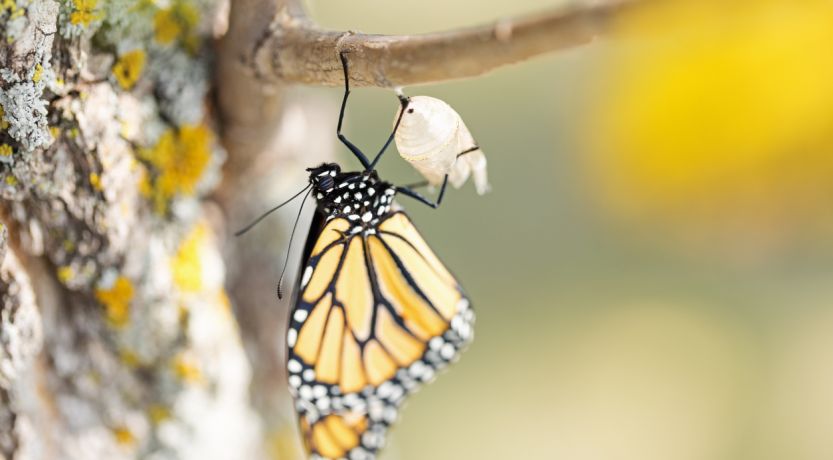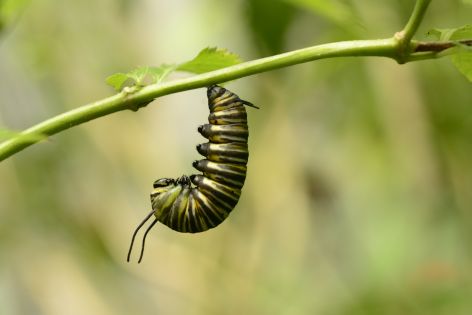The Incredible Monarch Butterfly: Evidence of Design?
The monarch butterfly undergoes awesome changes and migrates amazing distances. Is the monarch an example of evolution or design?

Years ago my wife and I planted a “butterfly bush” in our back yard. Around late August we often see beautiful monarch butterflies flying around and landing on the bush—taking in of the nourishment it provides.
The monarch butterfly is relatively large for a butterfly. Most monarch butterflies have a wingspan of about 4 inches long (though some other butterfly species actually have a wingspan of up to 12 inches!). Monarchs are known for their distinctive design and orange, black and white coloring.
Their bright coloring is a warning to those wishing to make a meal of the butterfly: Don’t eat me; I do not taste good!
And the monarch also has abilities many don’t know about—it actually has instincts that can enable it to fly across the Gulf of Mexico!
The more we learn about this amazing insect, the more evidence we see that its instincts and abilities came from a Master Designer and not by random chance.
The birth of the monarch butterfly
This insect arrives in the United States in the early months of summer. Those in the eastern U.S. migrate to and from Mexico’s oyamel fir forest. After traveling part of the way back north, the butterflies lay small eggs on the milkweed plant. Milkweed is essential for the survival of the monarch population.
The Arizona State University website says: “The worm-like larva grows inside the egg. When it is ready, the larva chews a small hole in the egg shell and wriggles its way into the world.”
It starts out small, but grows rapidly as it eats the milkweed plant. Because milkweed is poisonous to most creatures, feeding on it causes the caterpillars to taste bitter and unpleasant to predators—but God designed the caterpillar itself to be able to eat the plant without issue.
A monarch caterpillar preparing to transform into a chrysalis.
“The change inside the chrysalis is slow and gradual. The caterpillar’s body digests itself from the inside out. The caterpillar is attacked by the same sort of juices that it used in its earlier life to digest food. Many of the organs are hidden in the caterpillar and they take a new form within the chrysalis. The old body is broken down into imaginal cells but not all the tissues are destroyed. Some old tissues pass onto the insect’s new body. One imaginal disk will become a wing and there are imaginal disks that form the legs, antennae and the other organs of the butterfly.”
The butterfly eventually emerges from the chrysalis as an amazing flying creature—the beautiful butterflies we see in our backyard in the summer.
Think about the incredible complexity of the changes the monarch must make. Each change must occur to an exact specification, or the butterfly will not survive. If the wing of the butterfly is too small, it will not be able to fly. But, if the monarch becomes too large, it cannot muster enough energy to fly.
Some monarch butterflies must also be able to navigate over large bodies of water. They have something similar to a built-in GPS system to help them make this journey.
Evidence of intelligent design?
Think about what happens throughout this process. The changing from a chrysalis into a flying insect is almost like putting a Volkswagen car into a garage and then after a few weeks, without any outside help or extra parts, having it emerge as an airplane.
Think of the difficulty of taking the parts from a car and reorganizing them as a small airplane. It would take a great deal of planning in order to do this—if it could even be done at all!
Is it logical to conclude that the entire process a butterfly needs to go through to become an adult butterfly is the result of chance?
Migrating butterflies
The monarch butterfly goes on to do things that also seem to have been programmed into them by a Designer.
According to the Encyclopaedia Britannica: “Adults live only a few weeks, except for those that migrate south and overwinter in Mexico, which live seven to nine months. Thus, about four generations of monarchs occur annually.”
They must make sure they have enough energy to make the trip. Then they must somehow navigate many miles south to the oyamel fir forest in Mexico—a place they and their parents and their grandparents have never been. How do they know where it is? Doesn’t it seem logical that this complex level of instinct was embedded into these butterflies by a Designer?
For those who believe in the existence of the Creator God, this is evidence of His master design and intelligence.
The apostle Paul wrote: “For since the creation of the world His invisible attributes are clearly seen, being understood by the things that are made, even His eternal power and Godhead, so that they are without excuse, because, although they knew God, they did not glorify Him as God, nor were thankful, but became futile in their thoughts, and their foolish hearts were darkened” (Romans 1:20-21).
Solomon marveled at God’s awesome handiwork in His creation: “As you do not know what is the way of the wind, or how the bones grow in the womb of her who is with child, so you do not know the works of God who makes everything” (Ecclesiastes 11:5). God’s intelligence and power are many times greater than ours.
The monarch butterfly is truly an incredible little creature that can strengthen our belief in God as the Creator and Master Designer!
Date Posted: March 3, 2020



